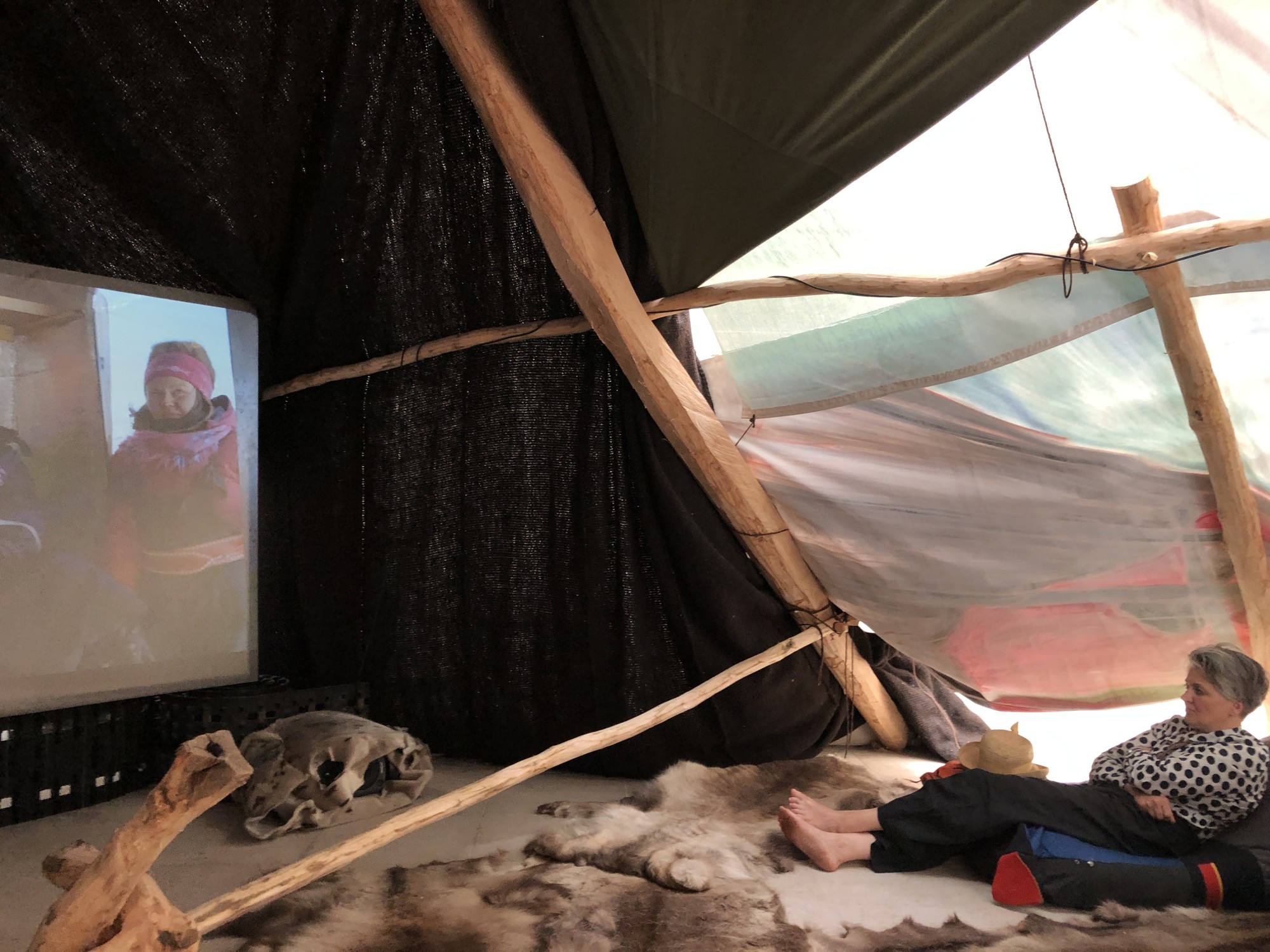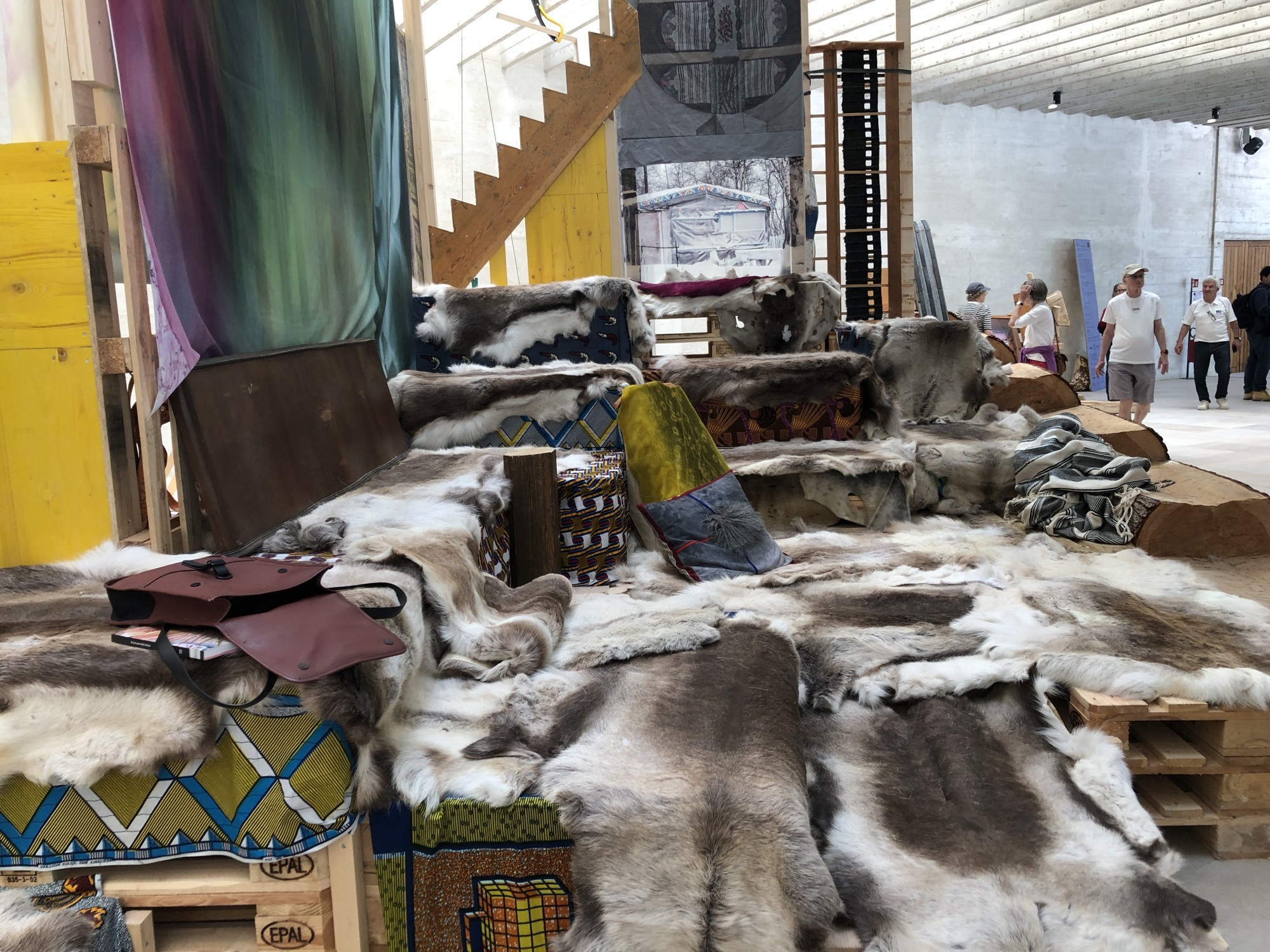Field Notes from the Pluriversity: Reflections on the 18th Venice Architecture Biennale
Stepping Back and Making Space: Speaking with Carlos Mínguez Carrasco
Stepping Back and Making Space: Speaking with Carlos Mínguez Carrasco
How does one display an entire culture? This is one of the questions Aaron Smolar and Yidan Li ask Carlos Mínguez Carrasco, co-curator of the Nordic Pavilion's installation of Sámi architecture. Over the course of the conversation, the three discuss curatorial and representational strategies can interpret and share indigenous epistemologies and spatial practices.
CMC: Carlos Mínguez Carrasco/ AS: Aaron Smolar/ YKL: Yidan Karel Li
I was wondering, since this is quite a complex installation with many moving parts and small pieces, if you could talk about its gestation. Were there any particular successes or challenges that you encountered along the way?
Sure. We are sitting in Girjegumpi, which is the Sámi architectural library, and this is a project that is led by architect and artist Joar Nango. He’s a Sámi architect—the Sámi are indigenous peoples of northern Scandinavia. They live in a region that extends from northern Norway, northern Sweden, and northern Finland, reaching the Kola Peninsula in Russia. The indigenous people of the north are called Sámi, and the land is called Sápmi. This is a library that gathers together a series of books and other literary forms focused on Sámi architecture and Sámi design. This is a project that Joar Nango has been developing for many years, but also with many collaborators. The process for him starts by asking, “What is Sámi architecture?” “What is indigenous architecture?” “What is indigenous design?”
He is one of the few Sámi people who has officially graduated from a school of architecture, and since his school years, he has been specifically interested in this topic. He started to accumulate books that talked about these topics because the reality is that there was not much literature—at least, definitely not that was taught in school—that had to do with these topics. So he started to think, “What are those books? Let’s put them all together. Let's gather them.” So he initiated, almost without thinking, an archive—an archive of Sámi architecture and Sámi design. Eventually, that archive got pretty big, and so he imagined a project that was called Girjegumpi, and that is a play on two words in Northern Sámi. The first is girji, which means book, and the second is gumpi, which is a storage box that is usually carried by cars or by motor skis in that region because the Sámi are semi-nomads, so they travel with reindeer—they herd reindeer. So the gumpi is a storage box for these people to transport materials. This is what we see here, this is a gumpi, and he used it to store these books, but he started to modify it, to change specific parts. He started to cut some walls such that, when the box arrived [at] a specific spot, those walls would unfold. Those spaces became spaces for conferences, lectures, seminars, and conversations about topics related to the books. That process grew and had different iterations, and each iteration had more books, more people involved in those conversations, and in every single location it started to adapt to the space where it was traveling.
What we see here today is another iteration that has been traveling for years in the northern region, and we invited Joar Nango and all of his collaborators to come to Venice and have a new iteration of the project. Here, we see the box unfolding, all of the books that he has been collecting in different categories over the years. We are sitting in a spot precisely to check the books, to talk to people around, and to learn about Sámi architecture.
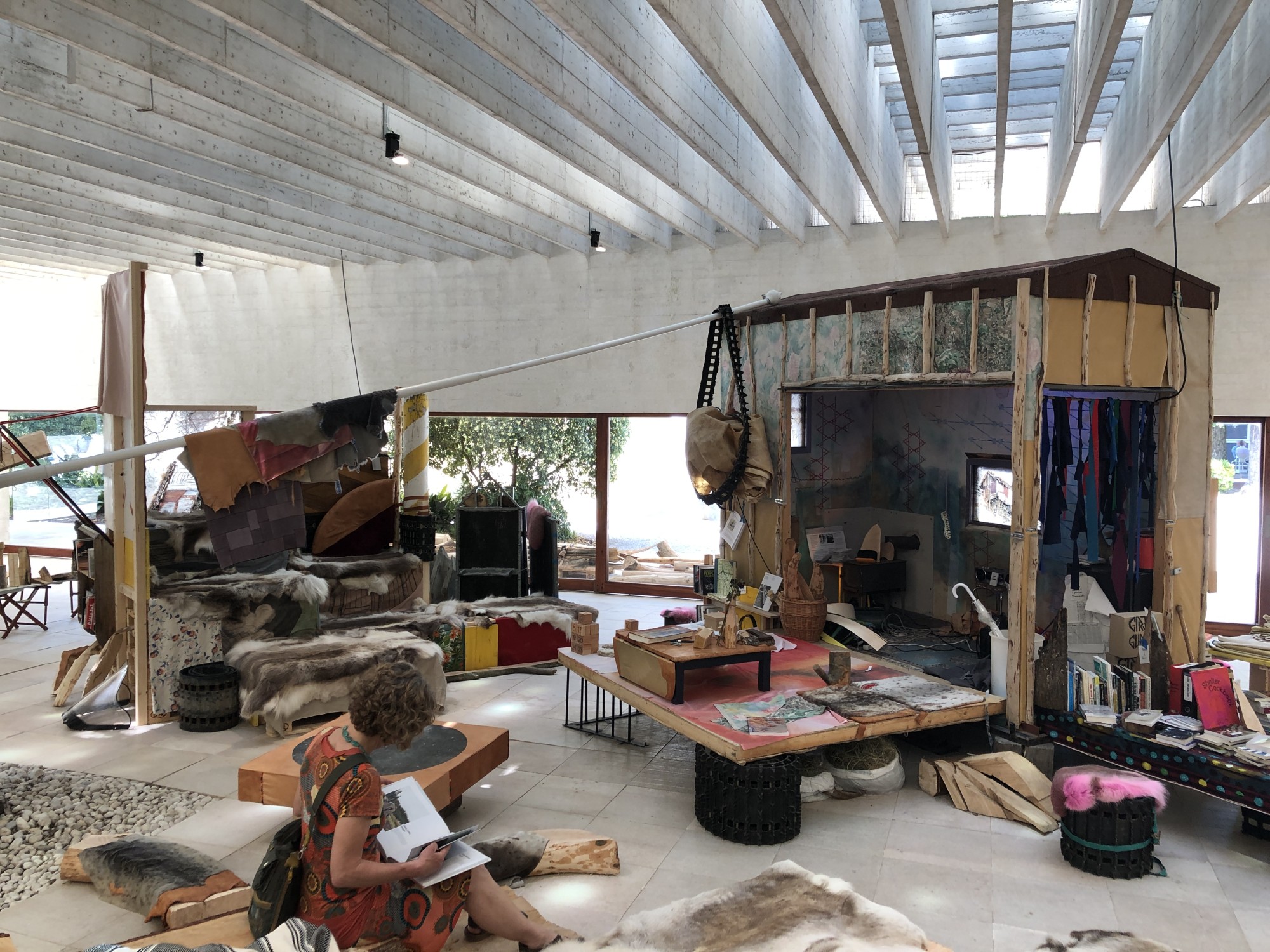
A few years ago, you spoke to one of my classes at Columbia with Jorge Otero-Pailos from the Historic Preservation department about your book Kiruna Forever. I was wondering how you find this project interfaces with that prior work. Do you see it as a continuation of that project?
For me, it is. Kiruna Forever was an exhibition that focused on a specific city that is located in the northern region of Sweden and is part of Sápmi. In that project, Joar Nango was invited; he was one of the participants in the exhibition. For me, it is part of an ongoing, long-term interest that we are developing in the museum—investigating the north’s complexities, different streams of transformations—radical transformations—that the Arctic region is experiencing. In those transformations, the layer connected to Sámi culture and Sámi design is an important one. Kiruna Forever was focused more on the transformations of the city itself, where Sámi culture and negotiations with these changes played an important role. In this case, we invited Joar Nango to present his work, to have a full focus and voice. But this does not mean that we will finish here. We already planned to continue with these topics in the museum. For us, it is very important to maintain those topics and to ingrain them in the different programs and projects that we will be doing in the future.
Another striking quality of the exhibition for all of us is the really strong multisensory emphasis: sound, smell, almost even taste. We are curious about the sensory complexities that are involved in curating a show of this nature.
The role that we—James and I—played as curators is more like that of facilitators. We brought everything that we could to help Joar Nango and his team to do what they do. We did not direct him to include more “sensoriality” in the pavilion. It is something that is part of the project, it is part of their work. In this case, our role has been to facilitate a platform for others to do things, and we have necessarily had to step back. It is very important to think that a project like this has to do with social and political means that are indigenous to Sámi. The region of Sápmi is a zone that has been colonized by Sweden, Norway, and Finland over many years. For us, we are representatives of the National Centre for Architecture and Design, which is a state-owned institution, so it was very important that we invite Joar Nango to present his work in the pavilion, and especially that we step back and give him the space to do this.
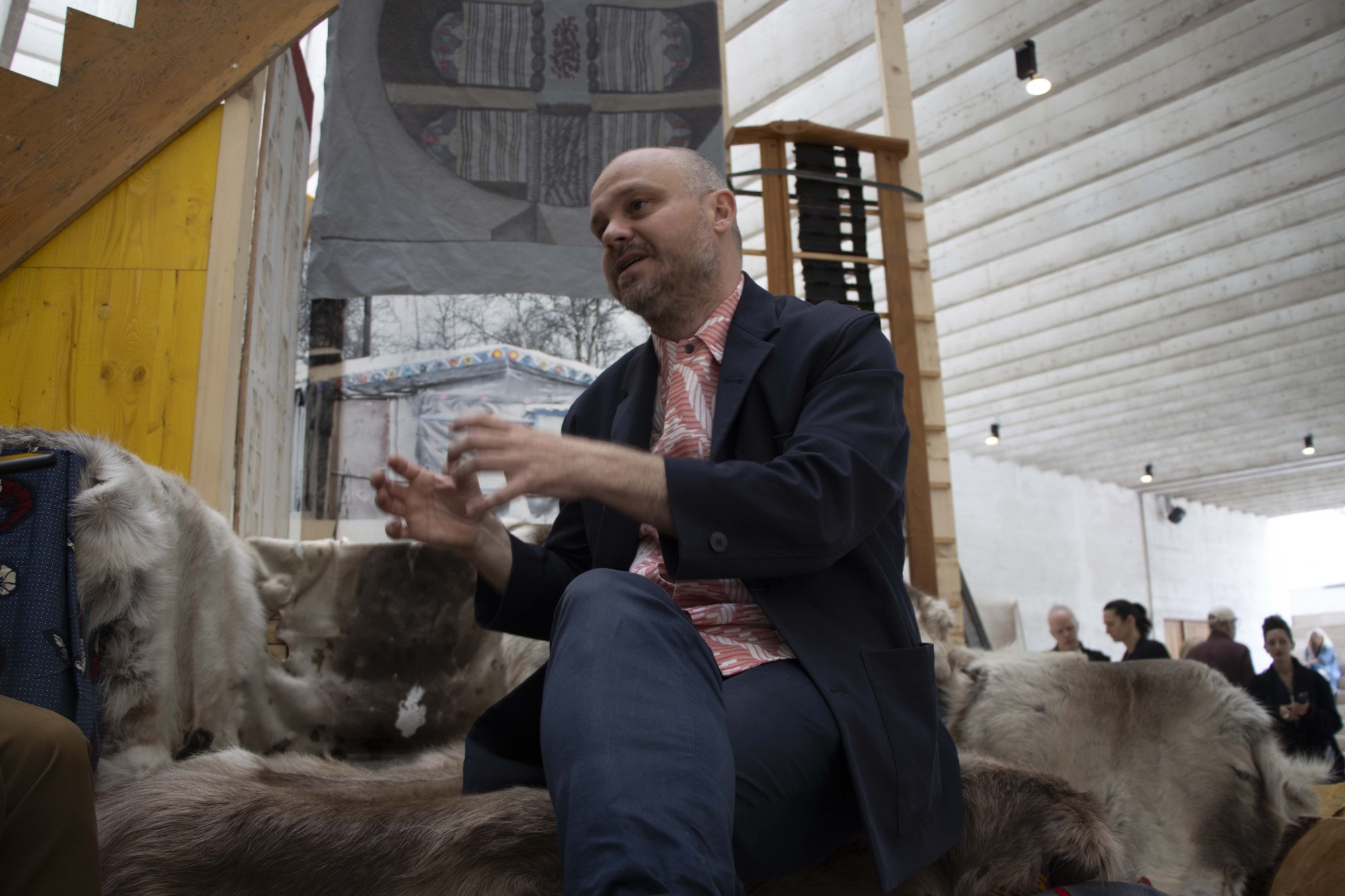
Did you find it challenging to take a more passive role?
I would say it is a typology, one kind of curatorial work. It challenges other forms that leave a more active curatorial imprint in the exhibition. It is simply one possibility, and is defined by the particular project. For example, in Kiruna Forever, I had much more involvement in the layers that we were focusing on, or in the selection of different artists, architects, and designers that we invited. But in this case, the project demanded that it be as welcoming as possible, and that process of welcoming and hosting required stepping back and responding to the requests, thoughts, and ideas that Joar Nango had.
I am interested in this exhibition as an architectural method to distribute knowledge. It is a library meant not only to store but also mobilize books and their contained knowledge. Does this idea have roots in Sámi tradition and culture at all?
Not really. The gumpi is a storage box. But it is true that the project intends to grow knowledge about a specific topic, and I think that the girjegumpi’s adapts to each specific location it travels embodies that conversation, that collaboration that builsd knowledge, as well as the archive. We understand the archive as knowledge that can be looked at, learned from, discussed, criticized, and questioned by a group of people. It is true that there is a connection between archiving and building here, and that is the project’s core. It is an architectural project at the same time that it is a knowledge-building project in the form of an archive. So there is a negotiation, not only with architecture, but also with art, design, filmmaking, and all of those things are enmeshed. I used to say that this is a positive architecture, in which architecture is material, sensorial, social; it builds a network of people. But it is also political. All of those components are intertwined in this installation.
The arrangement of the books suggests that there has been a spatial consideration. Can you talk about this?
The selection and categorization of the books is made by the artist, Joar Nango. Joar plays many different roles in this project. He is the archivist, artist, architect, but, as the archivist, he is also the community builder. He is the leader of the collaboration. He is a curator because he selects not only people with whom to work,but also specific materials to display and how they are displayed. The design’s spatiality is crucial for how the project adapts, and he also reuses the materials that he finds when he arrives [at] a specific location. You will also see a series of objects that have been found here in Venice because that is part of the process. In every iteration, he uses and reuses resources that are close to them. Once they finish, they will continue. They will leave some materials but they will bring some with them. So Joar Nango’s role here is manifold. It has many different elements, in which space, curation, and archival practices are involved.
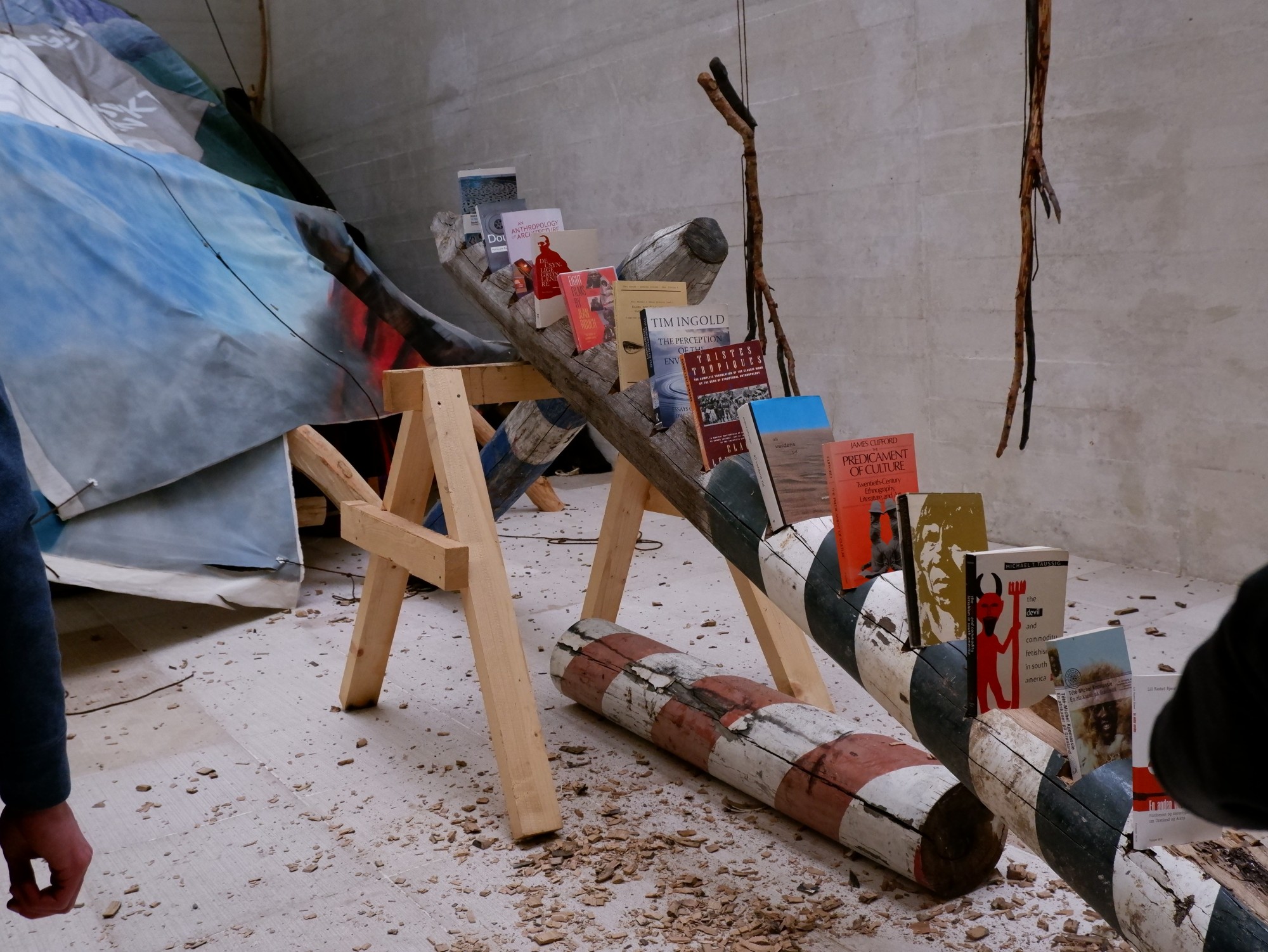
Did you talk about the dialogue with the original pavilion itself at all? We noticed that you are really activating the trees that were incorporated into the original design. Sverre Fehn is known for producing a sort of modernism that is adapted to Scandinavia. This installation takes that idea further, bringing indigenous typologies to a radically different context. Can you talk a bit about this dialogue?
It has been an important aspect of the project. This pavilion is an icon of modern architecture, and it is also very connected to the idea of “the North” or of “the Nordic,” so there is a symbolism that is connected to the pavilion itself. At the same time, it is a very difficult pavilion to work with because installations here are usually swallowed by the architecture. Many previous installations in this pavilion have tried to negotiate with the architecture. We found it a difficult challenge because the building has a very powerful presence. For us, this was one of the conversations that we had at the beginning of this collaboration—“this needs to negotiate with…,” “this needs to be in dialogue with….” That dialogue, for me, is one of this project’s amazing aspects because it is produced by volume and space, but also sometimes by specific connections to the structure overhead, or sometimes with delicate details and even humor. For example, there is a ski sledge hanging from one of the [ceiling rafters]. So it is an apologetic dialogue with a master of Nordic architecture. For me, that is very powerful because this is the only pavilion at the Biennale that is shared—it is the Nordic Countries Pavilion, so we [Sweden] share it with Finland and Norway.
We invited Joar Nango, who is part of a community that lives in a region that extends beyond the nation-state. So, for me, it is a dialogue between two completely different attitudes to what architecture or design is, and that dialogue is what produces that tension, that negotiation that is at the project’s core. It is building a space for discussion, to share different perspectives around the relevance of Sámi architecture in contemporary culture. That dialogue also has a relationship with the project idea itself.
I was wondering if you could talk about the installation’s afterlife as well. You said that there will be exhibitions in Stockholm….
One [central] aspect of the girjegumpi is that it will continue to live. This is just one iteration of many. After the Biennale finishes, this will be packed and returned to Sápmi. It will open in other places and continue to grow. So its life will continue. For me, it is also an important aspect of working for the Biennale. One of the difficult aspects of the Biennale is that many projects open, and when it finishes, they disappear. They do not have any continuity. This project is part of a personal interest to maintain [projects], to make sure that projects are not made for the Biennale. The projects exist, they are presented at the Biennale, but they continue in the form of programs, as resource lines in the museum.
Going back to the theme of this year’s Biennale, I was thinking about the ideas of decarbonization and decolonization, especially as they relate to the history and complexity of the Sámi territory. How did you seek to implement such two very large concepts here?
Well, like we were talking about before, the idea that the project will not end here, and materials for the project were brought from and will return to Sápmi to continue their life. This has to do with an understanding of cycles that are trying to minimize waste and trying to recycle and use locally sourced materials. In that sense, I think that the project is completely aligned with decolonization and decarbonization—not as a statement, but as a practice in itself. The way in which the Sámi live is due to the fact that they live in a resource-scarce area, so there is a lot of imagination and creativity in using local resources for everything that they do. And of course decolonization is a topic that is important for Joar as a way of thinking about the region, their work, and their identity, but, at the same time, I do not think that the project is a decolonizing project. I think that the project “Sámi-fies” the world, brings the knowledge, an apologetic understanding of their work and their world to other places. So in that sense, the project arrives here and is in dialogue with this modern pavilion. And that dialogue is what really produces the tension. I feel like decolonizing is a theoretical concept that is part of the construct of the Sámi architectural library. It is, of course, a tool for discussion, but I do not know if it is so central [to] the project itself.
The nature of displaying a culture…it seems difficult to strike a balance between something that is superficial and something that challenges preconceptions.
Absolutely, 100%. I was very aware of that process, and there is no interest whatsoever in the project to “present a culture.” What we have done is invite an architect to present his work, and his work happens to be connected to Sámi culture, to indigenous traditions, to political relationships with nation-states and a community that has a land. And our position, our work as curators, is to invite a great architect, and we have been very aware that we cannot speak on behalf of Joar Nango. We cannot try to tell, to pedagogically explain certain realities of a community to which we do not belong. So our intention is to provide a space for a great architect to present their work.
